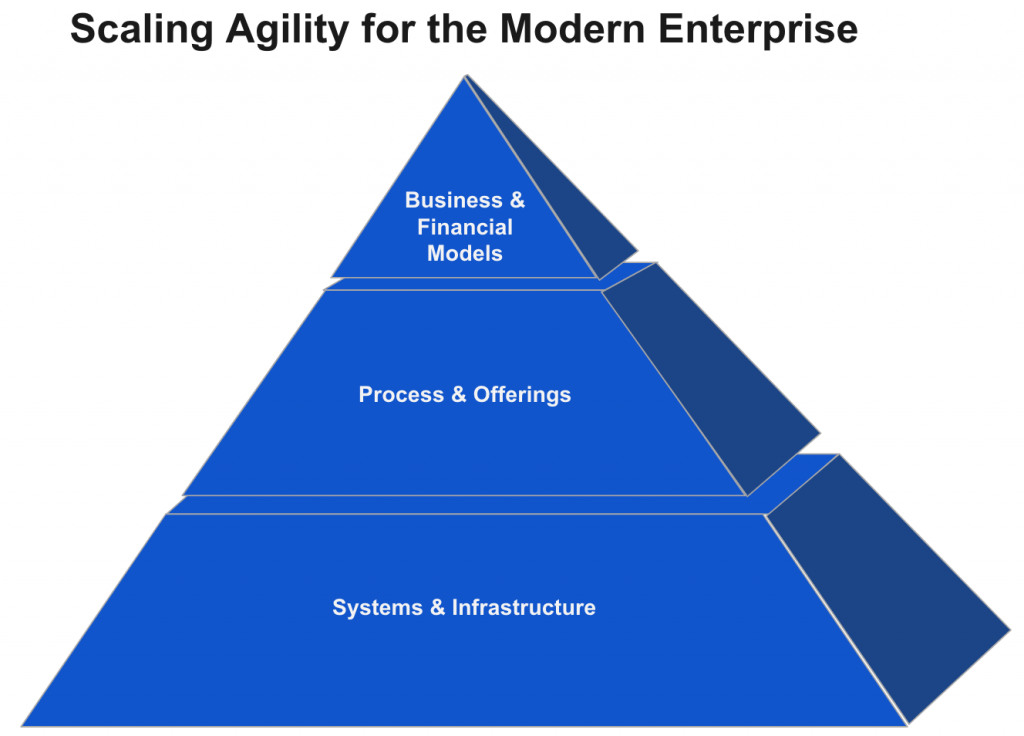As discussed in my previous blog post, the notion of the OODA loop is foundational for many of today’s common agile, LEAN and DevOps methods. But given we typically talk about it in a systems context, it’s important to examine the core motivations for enterprises becoming more responsive to changes in their environment.
Reframing enterprise agility
When we combine these two ideas we can start to visualize and measure agility as follows:
Agility, in the context of enterprise business, can be thought of as the ability to intentionally complete the OODA Loop and enact change for systems, processes, offerings, business models, labor, and more.

Within this conceptual frame, agility can be stratified into layers with each upper layer leveraging the operationalized capabilities in the layer beneath it.
The foundational layer “systems and infrastructure” is where teams typically apply Agile and DevOps methodologies. Sustained mastery of agility at this layer, enables organizations to focus efforts on smoothing and driving changes in enterprise “processes and offerings” which are often more difficult given the everyday impacts on both people and technology.
Just like the layer beneath it, sustained mastery of agility at the “process and offerings” layer, enables organizations to focus efforts on smoothing and driving changes in enterprise “business and financial models” which are amongst the hardest to achieve given the deep financial implications, business constraints and the ultimate test of market acceptance with a customer base that doesn’t take well to changes in their relationships with providers.
Industry-leading agility examples
As with any model, we can test its applicability through examples in the real world.
Agile business and financial models
- Amazon – Original offering of online bookstore organically grew into other retail categories and then spawned successful highly scalable offerings across industries regardless of brand elasticity or specific expertise (e.g., retail, consumer electronics, streaming media, subscription services, voice assistants, cloud PaaS, advertising, healthcare. etc.).
- Google – Launched as a search engine advertising platform targeted at consumers, Google has leveraged its expertise in scaling systems and infrastructure into multiple lines of business with wholly different operating models (e.g., enterprise SaaS, consumer electronics, telecommunications, navigation, streaming media, home security, etc.)
Agile process and offerings
- Salesforce – One of the first SaaS companies, Salesforce has leveraged their mastery of a decoupled infrastructure to constantly evolve its processes and offerings to customers. This agility has enabled Salesforce to remain compelling and relevant to businesses of all sizes despite the hyperspeed cycles of change across the software industry.
- Netflix – Practically owns their category as they have one of the most prolific infrastructure capabilities to scale product features/offerings to a very personalized set of capabilities to their customers. Netflix built a world class capability of systems and infrastructure management capability on top of AWS (Netflix can quickly deploy thousands of servers and terabytes of storage within minutes. Users can stream Netflix shows and movies from anywhere in the world, including on the web, on tablets, or on mobile devices) to enable their self-driven cannibalization of their mail-order DVD rental business. Netflix’s burgeoning mastery of the “Process & Offerings” layer of agility, is enabling their next level of transformation from media delivery into content development and has now become one of the largest and most successful media businesses in the world (evidenced by multiple global media companies selling off content development capabilities rather than compete with Netflix).
Agile systems and infrastructure
- Etsy – Ability to on board and scale sellers, buyers and products – 2017, close to 33.4 million buyers had purchased goods through the Etsy ecosystem.
- Facebook – Ability to scale users, capabilities, production offerings, analytics etc. to drive a very personalized experience – Approaching 2 billions users with ~1.4 billion daily users.
- Walmart – Ability to add digital offering enabled through an extremely fast and nimble logistics supply chain. – They’re part of one of the largest and safest fleets, and every year they drive 700 million miles to make millions of deliveries to our stores and clubs.
From model to measurement: Specific KPIs for each layer of the pyramid
When viewed as separate conceptual layers, each segment of the new framework has direct, observable KPIs that can be tracked and measured as elaborated below:
Business and financial model KPIs:
- New LOB time to market
- Consumer perception of brand elasticity
- Success rates of cross industry penetration
- New product scaling time and cost
Process and offering KPIs:
- New product time to market
- Market test cycle time
- Acquisition integration time and cost
Systems and infrastructure KPIs:
- MTTR (Mean Time to Resolution)
- Throughput (Story-points/Time, Function-points/time
- QA Test cycle time
- Batch size per deployment
- Lead time for changes (commit to deploy)
- Deployment frequency
- Deployment success rate
- System availability
- Defect escape rate
- MTBF (Mean Time Between Failure)
Making metrics work for you
Muleys across the globe work with enterprises at all stages of transformation and our customer success organization is constantly collecting and integrating learnings from each of these encounters. If you are working on driving agility or transformation efforts within your enterprise we’d love to hear from you regarding your efforts and how you are thinking about agility. We are always integrating and iterating and the larger community continues to play a key part as we all work towards our vision of the ubiquitous application network.
These learnings inform both the enterprise agility model described above, available in the hands-on guide to digital transformation.









